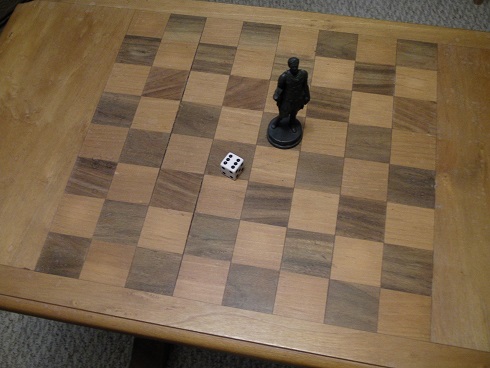Random Walk
A "random walk" is a demonstration of how a series of random events can produce a result that doesn't seem entirely random.
Here is an experiment you can do to demonstrate this. Get a chess or checker board, one chess piece or checker that you can move around, and a die. An example setup is shown below:

Place the board so that the far side is facing North. This puts the left side to the West, the right side to the East, and the close side faces South. Put the piece on one of the 4 squares in the very centre of the board. Now roll the die repeatedly and each time you roll it, move the piece according to the number showing:
- Move left (1 space toward the West)
- Move right (1 space toward the East)
- Move away (1 space toward the North)
- Move closer (1 space toward the South)
- Don't move it.
- Don't move it.
You can see that the odds are the same for each direction that the piece might move. You can expect to roll a "move away" just as often as a "move closer". Similarly you can expect to roll a "move left" just as often as a "move right".
So what do you think will happen? Each time you roll a 1, 2, 3, or 4, the piece will move. You might expect that it will wander around the board a bit, but that it would basically stay in the center of the board. That's because it will move left about as often as it moves right, and it moves toward you about as often as it moves away.
However, if you actually try this out, eventually you will discover that the piece wanders off one edge of the board. You can't predict which side it will come off, but eventually it is sure to come off one side or the other.
The reason for this is that each new random event does NOT depend on the previous ones. Suppose that your first roll brings the piece to the left. Is it now more likely that another roll will take it to the right? No! Each roll is independent of the previous one. So you now have the piece a little closer to the left of the board. The odds are the same that it could go any direction. We no longer have equal odds of it eventually falling off any side, because it's closer to one side than to the others.
This "random walk" is a well known fact of statistics. Even with a die that produces a random number, the piece will wander around and gradually reach some destination. As a matter of "empiricle verification" I have tried it myself many times and sure enough, the piece always reaches one of the four sides.
This is the same phenomenon that occurs in the "rules of the road" simulation. The odds of each driver choosing a left-hand or a right-hand choice are exactly the same, but as the random events occur they effectively take the drivers on a path. In that simulation there aren't 4 sides of a board to fall off of, but only 2 outcomes. Eventually the random actions will take them to one of those 2 outcomes.
What do you think of the content on this web page?
| Site Search | |
Return to Universal Ethics home page |